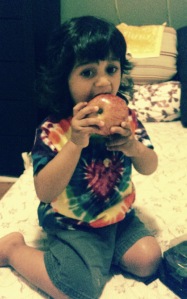Dear Amma: My doctor has put me on medication for gestational diabetes. I have tried to keep my glucose levels down but it is very difficult – the other day I ate just a couple of spoons of potato and the level shot way up. I get hungry all the time and I am running out of ideas for things to eat that will keep me full.
– Eating for 2
Dear Eating for 2,
You know the drill: Eat a variety of foods that are high in fiber, have a low glycemic index and are nutritious. National Institutes of Health offers these diet recommendations.
To start, consider that whole foods tend to have a lower glycemic index than their refined counterparts. Or in the words of The World’s Healthiest Foods, “Foods that are white tend to have a higher glycemic index.” So make sure whatever you are already eating is whole. Your rice is brown, your bread is whole-grain or sprouted grain, and your fruits and vegetables, mung dal, urad dal, etc are unpeeled. Want even more fiber? Stir some wheat bran or oat bran into the batter you use for dosa or pesarottu.
Next, try to diversify your grain basket, with barley, ragi and other varieties of millets, oats, and quinoa. Kamut and amaranth (राजगिरा or चौलाई) are available puffed, for easy snacking.
Let’s not forget omega-3 fatty acids, found in a variety of vegetables and notably in flax seeds, walnuts and their oils. Your entire family will benefit from these improvements, and baby will be used to a healthy, diverse, whole foods diet from the start! Note that flax seeds are so small that you have to take care to chew them. If you don’t they may pass through undigested. If you grind your flax seed, you should eat it the same day – or within a few days if you refrigerate it. Ground flax seed makes a decent dip for idli, dosa, etc.
Though I did not have GD, I too remember hungering for new and different foods in the third trimester. After eating one dosa I would still be ravenous, but not want another dosa. Repeat with one hummous sandwich, one plate of vegetables, and so on.
One trick that helped me stay full longer was adding wheat germ to whatever I was eating. I would add a spoon or two to my rice and sambar, or sprinkle it on bread along with a spread. Stir some into a bowl of oatmeal or upma. A tablespoon of wheatgerm contains 2 grams of protein, so a little goes a long way.
Are your idli and dosa whole grain? You can increase their protein content by using 1 cup dal per 1 cup rice. A treasure trove of recipes using several varieties of millets includes simple preparations like కొర్ర పెసరోట్టు – see korra pesarottu on the site of Earth360.
Looking for ways to eat oats? Try Oatmeal Sabzi or steel-cut oats. How about quinoa? Here is a simple recipe for delicious quinoa upma.
